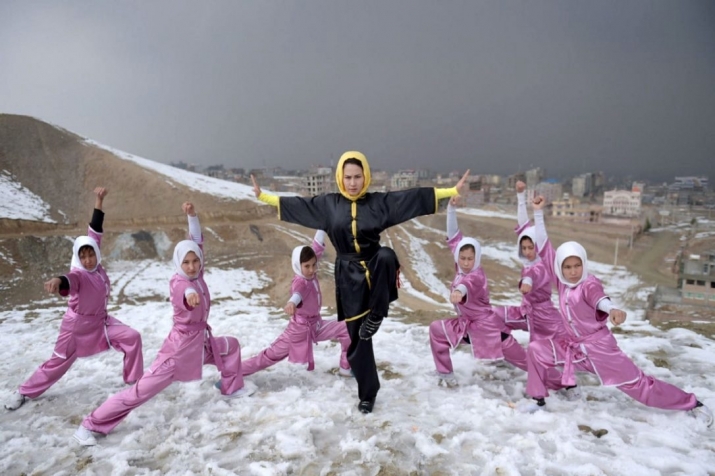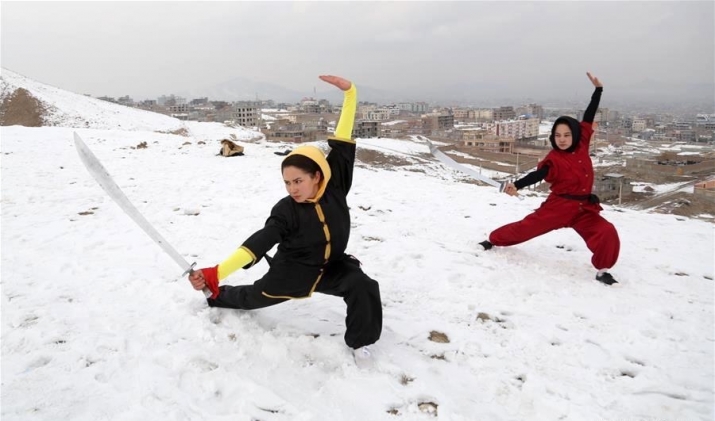NEWS
Afghan Women Find Strength in Shaolin Tradition
 Members of the Shaolin Wushu Club in Kabul, led by trainer Sima Azimi, center, practice on a hilltop overlooking Kabul. Photo by Wakil Kohsar. From thestar.com
Members of the Shaolin Wushu Club in Kabul, led by trainer Sima Azimi, center, practice on a hilltop overlooking Kabul. Photo by Wakil Kohsar. From thestar.comAt just 20 years old, Sima Azimi is already a woman with a mission. By teaching the 1,500-year-old tradition of Shaolin martial arts, she hopes to become a force for female empowerment in modern-day Afghanistan, and a warrior in the fight against gender bias. The Shaolin Wushu Club, which Azimi opened in western Kabul two years ago with the help of her father, is the first such Chinese martial arts group in Afghanistan for female students.
“I like to help girls in my country in order to improve their skills, so they can be the same as girls in other countries,” Azimi declared. “Also, I want to help bring an end to violence against women in Afghanistan.” (Tolo News)
Girls in Afghanistan are often discouraged from participating in sports that are perceived as aggressive or physically demanding—many parents fear an accident could result in a girl breaking her hymen before marriage, which is considered deeply shameful in the country’s conservative culture. “Some of my students’ families had problems accepting their girls studying Wushu,” Azimi noted. “But I went to their home and talked to their parents.” (Associated Press)
Having overcome her parents’ initial reluctance to let her train with Azimi, 15-year-old Latifa Safayi, embodies her teacher’s determination to break free from the restrictions of tradition. “I am the first lady in my family to do sport,” she said, emphasizing her dream of representing Afghanistan as a Wushu practitioner on the international stage: “I want to change the image of Afghanistan; [it’s] too well known for war and drugs.” (The Star Online)
When Azimi was two years old, her family fled to Iran to escape the rule of the Taliban regime, and it was there that Azimi discovered Wushu. Azimi spent three years studying the Chinese martial art in Isfahan—where she also competed in two competitions, walking away with bronze and gold medals—before her family returned to Afghanistan.
One of the biggest obstacles for Azimi since then has been readjusting to life in her home country. “Iran is a developed country, but here in Afghanistan there are some very conservative thoughts to fight,” she observed. “In the beginning, when I opened my private club two years ago to teach Wushu, no girl dared to attend at first, but gradually the number increased and presently 20 girls attend the club to practice this art of self-defense.” (The Star Online, Agencia EFE)
So far, all of Azimi’s students have come from the local Harzara community, the third-largest ethnic group in Afghanistan, to which she also belongs. Practitioners of Shia Islam, Hazaras are among the more liberal communities in the country, and Hazara women have greater freedom and more independence than some segments of Afghan society. “Unfortunately, we have only Hazara students here and I don’t like this, I am not comfortable with this solo ethnicity in my club,” Azimi said, adding she wanted to welcome girls from other communities to her school. (The Star Online)
“My prime objective is gender equality between men and women in Afghanistan,” Azimi said with conviction. “And that’s why I’m calling on all girls to break down the cultural barriers and join me in promoting Wushu to achieve this goal.” (Agencia EFE)
 Azimi, left, teaches Wushu to 20 Afghan girls, the oldest of whom is 20 years old and the youngest is 13. Photo by Rahmat Alizadah. From news.xinhuanet.com
Azimi, left, teaches Wushu to 20 Afghan girls, the oldest of whom is 20 years old and the youngest is 13. Photo by Rahmat Alizadah. From news.xinhuanet.comShaolin Wushu, also known as Shaolin Kung Fu, is one of the oldest Chinese martial art traditions, and is believed to have originated and been developed at the Chan Buddhist Shaolin Temple in the central Chinese province of Henan. The monastery is popularly believed to have been established in 495 CE, although it has been destroyed and rebuilt many times during its history. The name of the monastery is derived from the nearby forests of Shaoshi Mountain, one of the seven peaks of the Song mountain range. The monastery and its nearby Pagoda Forest were listed as a UNESCO World Heritage Site in 2010. The monastery’s first abbot was Batuo (Buddhabhadra), a Dhyana meditation master believed to have come to China from India or Greco-Buddhist Central Asia in 464 to spread Buddhist teachings.
See more
AFGHAN WOMEN PRACTICE ANCIENT SHAOLIN MARTIAL ARTS (Associated Press)
Afghan girls fight back through Wushu (Agencia EFE)
Wushu Girls From Kabul Determined To Succeed (Tolo News)
The wushu women of Kabul (The Star Online)
In pics: Shaolin Wushu in Kabul, Afghanistan (Xinhuanet)
Shaolin Temple
Related news from Buddhistdoor Global
“Kung Fu Nuns” Arrive At India’s “Golden Temple”
Gyalwang Drukpa Leads “Kung Fu Nuns” on Bicycle Pilgrimage to New Delhi
Controversy-plagued Abbot of Shaolin Monastery Comes under Official Scrutiny
Related features from Buddhistdoor Global
Buddhistdoor View: The Case for Rebuilding the Bamiyan Buddhas to Their Original Glory
The Druk Amitabha Kung Fu Nuns: Combining Martial Arts and Meditation
Celebrity Spotlight: The Lightning-fast Buddhist














